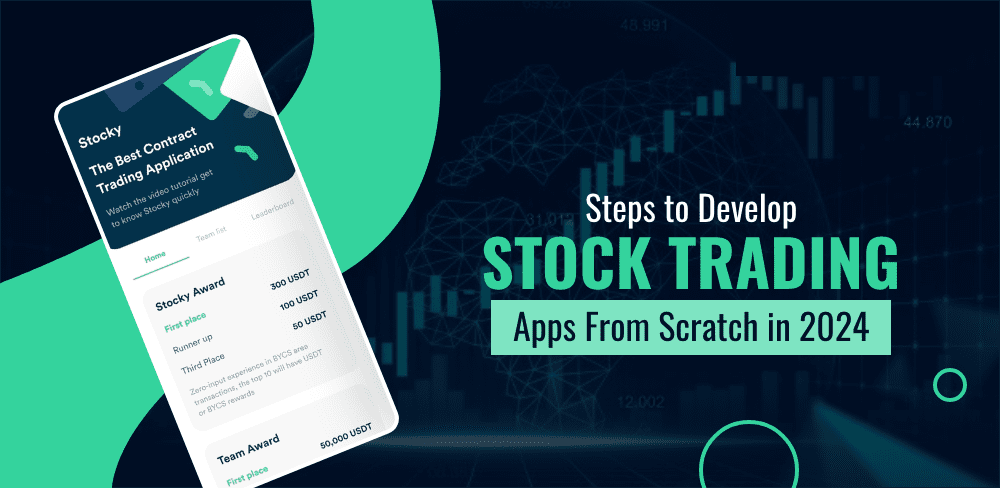Welcome to 2024, the exciting world of app development for stock trading! To navigate the financial markets, you need cutting-edge technology. To develop Stock Trading apps from scratch requires a strategic approach. This blog will guide you through all the steps necessary to create a user-friendly and robust app like stock trading.
We’ll cover everything from conception to deployment: market analysis, design, backend development, and security protocols. Keep an eye out for our comprehensive journey into stock trading app development. It will help you navigate the ever-evolving world of finance and tech. These steps are valuable for both seasoned developers and curious investors.
What is a Stock Trading App?
Stock trading apps are digital platforms that allow users to trade stocks, securities, and other financial instruments via mobile devices. These apps provide real-time data to allow users to track stock prices, analyze trends, and make quick trades.
Stock trading applications often have user-friendly interfaces that make them accessible to novice and experienced traders. Portfolio management, financial updates, and customizable alerts are features that most stock trading app development offers. These apps allow users to make informed investment decisions and facilitate a seamless trading experience.
Features to Add In Your Stock Trading Apps From Scratch
Before diving into the stage of developing Stock Trading apps, it is crucial to know that you must carefully consider the features. Here are 15 features you should include in your stock trading application:
1. User Authentication & Security
To ensure the safety of user accounts, implement robust authentication mechanisms such as two-factor verification. Protect sensitive financial data and transactions by using encryption protocols and secure connections.
2. Real-time Market Data
Users should have real-time access to stock prices, market indexes, and other financial data. Use reliable data sources to deliver accurate and current information to users so they can make informed decisions.
3. UI/UX
Create an intuitive, user-friendly interface that enhances the overall experience. Prioritize clarity and simplicity to allow users to navigate the app quickly and execute trades.
4. Portfolio Management
Apps that allow users to manage and track their portfolios can be integrated into the app. Include features such as performance analytics, asset distribution charts, and historical portfolio data to assist users in assessing their investment strategy.
5. Watchlists and Alerts
Users can create watchlists to monitor specific stocks and customize alerts when price changes or news is updated. This feature helps users make timely decisions and keeps them informed.
6. Order Placement and Execution
Offer an efficient and seamless system, allowing the user to place orders quickly. Implement market orders, stop-loss, and limit orders to cater to various trading preferences.
7. News and Research Integration
Integrate financial research and news to keep users up-to-date on market trends. Access to company reports, expert analyses, and breaking news can help users make informed investment decisions.
8. Tools for Technical Analysis
Include technical analysis tools like charts, indicators, and trendlines to help users analyze stock price movements. Users can perform technical analysis in depth directly from the app using advanced charting features.
9. Social Trading and Community Features
Social trading can help create a community. Users can follow and interact with other investors, exchange insights, and view successful investor’s trading activities. It can increase user engagement and offer learning opportunities.
10. Education Resources
Provide educational resources like articles, videos, and tutorials to help users better understand stock trading strategies and concepts. Apps with educational content will appeal to both novices and experienced investors.
11. Customer Support and chatbots
Use live chat or chatbots to respond quickly to user questions. Customer support that is quick and responsive increases user satisfaction and trust.
12. Account Statements and Transactions History
Users can receive detailed account statements, including transaction histories. This feature allows users to track their performance and record all their financial transactions within the app.
13. Push Notifications
Use push notifications to inform users about important events such as price alerts, executions of orders, and other critical information. Users can customize their notification settings to keep up with the market without feeling overwhelmed.
14. Multi-Platform Compatibility
Compatibility across devices and platforms, including desktops, smartphones, tablets, and other mobile devices, is essential. The responsive design and cross-platform functionality improve accessibility and convenience.
15. Features of Regulatory Compliance
Integrate features to ensure compliance with industry standards and financial regulations. It is essential to adhere to Know Your Customer procedures (KYC) and other regulatory requirements to ensure a safe and legal trading environment.
How to Develop Stock Trading Apps From Scratch?
Now, the time has come when you should develop Stock Trading apps from scratch. In the ever-changing landscape of financial technologies, a strategic approach is required to develop a stock trading application from scratch by 2024. It requires a team with a high level of expertise. This guide will take you through all the necessary steps to create a successful stock trading app.
1. Market Research and Analysis
It is the first stage to develop Stock Trading apps in which you should conduct thorough market research before diving into development to identify trends, user preference, and competitor strength. Analyze current stock trading to identify opportunities for differentiation and innovation. During this phase, a skilled development team can provide valuable insight that will help define the app’s unique features.
2. Define Core Features and Functionalities
It is the second stage to develop Stock Trading apps in which you should work with your developer to define your stock trading application’s key features and functions. Real-time data, intuitive interfaces, secure authentication, and seamless trade execution are all important. Hire Indian developers to ensure the app’s architectural support for scalability.
3. Regulatory Compliance
It is the third stage to develop Stock Trading apps in which you should keep up to date with the latest compliance and financial standards. Working closely with your developers, ensure you adhere to the industry’s regulations and integrate robust security. A competent development team can help you navigate the complicated landscape of financial compliance and ensure that your app meets legal requirements.
4. Select the Right Technology Stack
It is the fourth stage of developing stock trading apps. You should hire dedicated developers to help you choose your app’s technology stack. Consider factors like real-time data processing, scalability, and device compatibility. Expert developers can help you choose the best programming languages, frameworks, and databases for a reliable app.
5. UI/UX Design
It is the fifth stage of developing Stock Trading apps in which you should work with designers and developers to create an intuitive, user-friendly interface. Focus on simplicity and clarity to ensure users can navigate the app quickly and complete trades without issues. A talented development team will design a functional and visually appealing interface to enhance the user experience.
6. Backend Development
Build a robust infrastructure for your backend in collaboration with your developers. It will allow you to handle large volumes of transactions and data. Implement secure APIs to integrate seamlessly with trading platforms and financial data sources. Hire Android app developers who will optimize the performance and ensure minimal downtime.
7. Security Measures
The financial industry is a very secure sector. Work with your developers to develop encryption protocols, secure authentication procedures, and regular security audits. Use the expertise of your developers to protect financial transactions and user data by staying ahead of new security threats.
8. Real-Time Data Inclusion
Apps that trade stocks rely on market data in real-time. Working closely with your team, integrate reliable data sources to ensure users receive timely updates. Developers with experience will use efficient data processing methods to minimize latency and provide users with accurate information.
9. Testing and Quality Assurance
Prioritize thorough testing to identify and fix potential issues before launching your app. Work with your team to test all features, such as market data accuracy, trade execution, and security. A well-trained testing team can help ensure the user experience is smooth and error-free.
10. Deployment & Optimization
Coordinate with your development team to install the stock trading application on your intended platforms. Monitor feedback from users and performance metrics to identify optimization opportunities. Engage your developers to improve your app’s performance by addressing issues that may arise after launch and by implementing new updates.
11. User Education and Support
Provide robust customer service and comprehensive user education. Work with your team to develop tutorials, FAQs, and in-app instructions to guide users through the platform. It is essential to have a responsive support system that includes direct communication channels for users’ queries and concerns.
12. Iterative Development and Future Enhancements
Your team should adopt an iterative mindset to continuously improve your app based on user feedback and market trends. In close collaboration with developers, plan and implement future improvements, including new features, trading instruments, or integration with emerging technology.
How Much Does It Cost To Develop Stock Trading Apps From Scratch?
Now that you know how to develop Stock Trading apps in 2024 it is important know its cost., the development of stock trading applications from scratch will require a combination technology, expertise and regulatory compliance.
To accurately estimate the stock trading app development cost, you must understand the scope of the project, the features and the complexity. This guide will break down key factors that influence the cost, and give a rough estimation along with a cost breakdown table.
1. Scope and Features
The cost to develop Stock Trading apps is directly influenced by the scope. Apps with basic features like real-time data, trade execution, secure authentication and authentication will cost less than platforms that offer advanced analytics, algorithmic trading and social trading.
2. Technology Stack
The choice of the technology stack has a significant impact on development costs. The cost to develop Stock Trading apps depend on high-performance, scalable technologies can be higher. They are essential for the reliability, speed and security of your app. Select a stack in collaboration with your mobile app development company that matches your app’s needs.
3. User Interface (UI), and User Experience Design (UX), both
The success of an app is largely dependent on the user interface. The cost of UI/UX is higher, but the end result is a more engaging and satisfied user base, which ultimately impacts the success of the app.
4. Backend Development
Costs to develop Stock Trading apps is influenced by the complexity of backend infrastructure. This includes data processing, security, and integration to financial data sources. The cost of developing a robust, real-time backend that can handle data and transactions in real time is higher because it requires highly skilled android app development company.
5. Security Measures
In the financial sector, security is of paramount importance. The upfront costs of implementing advanced security measures, encryption protocol, and regular audits are higher. These measures are necessary to protect user data and maintain trust.
6. Regulatory Compliance
The development process is made more complex and expensive by the financial regulations. Work with your Trading app development company to make sure that the app complies with all legal requirements. This may require additional testing and development efforts.
7. Testing and Quality Assurance
It is important to conduct thorough testing in order to identify and address potential issues prior the launch of an app. Allocate resources to thorough testing including security testing, performance testing and functional testing. This adds cost, but is necessary for a reliable app.
Note: The percentages shown in the table are a rough estimate of costs associated with each stage. Actual distributions may vary depending on the project.
Development Stage |
Estimated Cost (%) |
|
Market Research and Analysis |
5 |
| Define Core Features and Functionality |
7 |
|
Regulatory Compliance |
8 |
| Choose the Right Technology Stack |
10 |
|
UI/UX Design |
12 |
| Backend Development |
15 |
|
Security Measures |
13 |
| Real-Time Data Integration |
10 |
|
Testing and Quality Assurance |
10 |
| Deployment and Optimization |
5 |
|
User Education and Support |
5 |
| Iterative Development and Enhancements |
5 |
The cost of developing stock trading apps in 2024 will be influenced by a number of factors. You can estimate your budget by carefully evaluating the project’s scope, features and technology stack. It is important to work with a stock trading app development team that has experience in stock trading apps. This will help you estimate costs accurately and ensure a successful implementation. This breakdown is a guide only. Actual costs can vary depending on the project and market conditions.
Conclusion
To develop Stock Trading apps in 2024 requires strategic planning and expertise. Each step, from market research to implementation, is critical. DevelopersPerHour offers cost-effective rates and a team of skilled professionals ready to make your vision a reality. Hire mobile app developers who are experts in creating robust and user-friendly stock trading apps while ensuring regulatory compliance. We navigate the complexity of financial technology with a commitment to quality to deliver cutting-edge solutions. DevelopersPerHour will guide you through a smooth development process, giving you the tools to succeed in the dynamic stock trading app world. We are committed to your success.
The FAQ
1. How Much Does It Cost To Develop Stock Trading Apps From Scratch?
Costs vary depending on the features and complexity. A simple app can start at $50,000, while complex platforms cost more than $200,000. The final cost is influenced by customization, security, and the technology stack chosen.
2. How Long Does It Take To Develop Stock Trading Apps From Scratch?
The typical development timeline is 6-12 months. Project duration can vary depending on features, complexity, and regulatory compliance.
3. What Are The Benefits of Developing Stock Trading Apps?
The benefits include real-time access to the market, easy-to-use interfaces, portfolios, and educational resources. Apps provide convenience, a personalized trading experience, and insight for making informed investment decisions.
4. Why Should You Choose Dev Technosys To Develop Stock Trading Apps From Scratch?
Dev Technosys excels at creating robust, secure, and scalable stock-trading apps. We are a leading choice in seamless development because of our expertise, commitment, and cost-effectiveness.
5. How Can You Monetize a Stock Trading Apps From Scratch?
Among the options for monetization are commissions per trade, subscriptions to premium features, sponsored content, and partnerships. Revenue can be generated by in-app advertising and premium data analytics.








